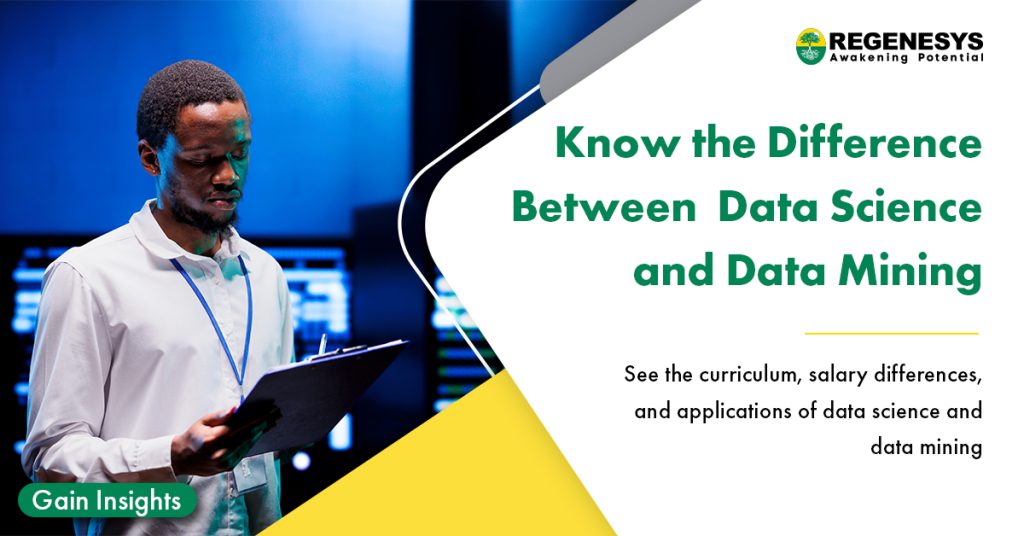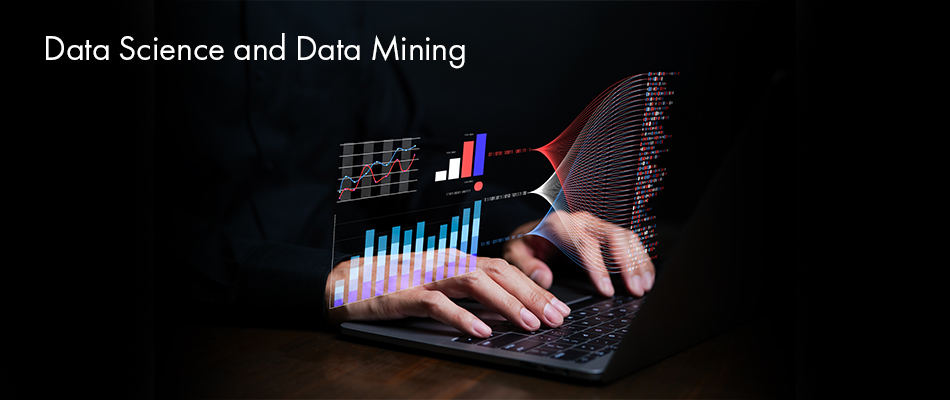Today, data has become one of the most valuable assets for businesses and organisations across various industries. The ability to collect, analyse, and interpret large amounts of data has transformed the way decisions are made. This has enabled businesses to achieve better outcomes and develop more strategic plans. To make these procedures easier, two key fields have emerged in this data-driven environment- Data Science and Data Mining.
While they both play crucial roles in extracting insights from data, they have different goals and use distinct methods. Understanding the key difference between Data Science and Data Mining is important for anyone interested in a career in data analytics.
In this article, we will explore what each field involves and how they are used in practice. We will also explore curriculum and salary difference between both these approaches.
Table of Contents
- What is Data Science?
- Key Application of Data Science
- What is Data Mining?
- Top Application of Data Mining
- Difference Between Data Science and Data Mining
- Data Mining vs Data Science – Curriculum Difference
- Salary Difference Between Data Science and Data Mining
- Data Mining vs Data Science – Which One to Choose?
- Conclusion
- Difference Between Data Science and Data Mining – FAQs

What is Data Science?
Data Science is an interdisciplinary field that involves collecting, processing, and analysing large amounts of data to extract valuable insights. It combines principles from statistics, mathematics, and computer science with specialised programming. Additionally, it uses advanced analytics, artificial intelligence (AI), and machine learning. By applying these techniques, data scientists can find patterns and trends within structured and unstructured data. This will guide business organisations across various industries to make better decisions and engage in more strategic planning. So, as you are learning the key difference between data science and data mining, you must now know what data science is.
Key Application of Data Science
Data science is changing the way industries work by transforming vast amounts of data into actionable insights. From predicting future trends to enhancing business strategies and optimising operations, data science offers powerful tools and techniques to solve complex problems and drive innovation. Hence, as you understand the key difference between Data Science and Data Mining, take a look at some of the key applications of Data Science:
- Predictive Modelling: Uses historical data and machine learning to forecast future events, like customer purchases or market trends.
- Natural Language Processing (NLP): Enables computers to understand human language, powering chatbots, sentiment analysis, and text summarisation.
- Business Intelligence: Analyses large datasets to inform strategic decisions, enhancing business performance and competitiveness.
- Recommendation Systems: Suggests products, services, and content based on user behaviour, enhancing user experience in e-commerce and media.
What is Data Mining?
Data mining is the process of analysing large sets of raw data to identify patterns and extract useful information. It involves sorting, filtering, and classifying data to reveal hidden trends and relationships. This technique helps businesses understand customer behaviour, predict future trends, and solve complex problems.
With the help of data mining, organisations can find valuable insights from data, which can guide decision-making, improve marketing strategies, and enhance operational efficiency.
However, while you learn the essential difference between data science and data mining, you must know that data mining is a key part of data science. It contributes significantly to the knowledge discovery process by transforming large volumes of data into actionable knowledge.
Top Application of Data Mining
As you explore the difference between Data Science and Data Mining, it is essential to understand how data mining optimises business operations and drives advancements in scientific research. The following applications will show you how data mining solves complex problems and deliver valuable outcomes:
- Scientific Analysis: Data mining techniques analyse large datasets from scientific research for insights, such as in bioinformatics and astronomy.
- Intrusion Detection: Identifies unauthorised network activities and anomalies to enhance cybersecurity.
- Business Transactions: Optimises decision-making by analysing transaction data for marketing, trading, and customer segmentation.
- Market Basket Analysis: Reveals purchase patterns to boost sales strategies and customer retention.
Difference Between Data Science and Data Mining
While both data science and data mining aim to extract valuable insights, they differ in their approaches and applications. The table given below will highlight the key difference between data science and data mining, helping you choose the right approach for your data needs:
| Aspects | Data Science | Data Mining |
| Definition | Data science is a field that includes the process of gaining meaningful insights from both structured and unstructured data by using diverse tools and techniques. | Data mining is a technique that involves the extraction of valuable insights, patterns, and trends from large datasets. |
| Scope | It is a broad field involving data collection, analysis, and deriving actionable insights. | Focuses on finding useful information and identifying hidden patterns. |
| Components | Includes statistics, data visualisations, social sciences, NLP, and data mining. | Primarily involves analysing structured data to find patterns. |
| Type of Data | Handles all types of data: structured, unstructured, and semi-structured. | Mainly deals with structured data. |
| Focus | Emphasises the science of data, including forecasting and strategic insights. | Concerned with identifying patterns and detecting anomalies in data |
Also, gain insights into data science vs data analytics to understand their difference.

Data Mining vs Data Science – Curriculum Difference
Another essential difference between data science and data mining is its curriculum. Here, we have given an overview of the curriculum differences between data science and data mining to help you get clarity on the distinct approaches and skills associated with each field.
Data Science Curriculum
Learners can improve their data analysis and computational skills through data mining programmes like the Postgraduate Diploma in Data Science. These programmes cover a range of topics that equip learners with the skills and knowledge to solve complex problems and drive strategic decision-making. Here are some of the core modules included in a data science curriculum:
- Statistics
- Programming Languages like Python
- Data Visualisation
- Data Storytelling using Power BI
- Deep Learning with Artificial Neural Networks
Data Mining Curriculum
The Data Mining curriculum equips learners with essential skills and principles in data mining. It will help learners thoroughly understand data mining techniques, preparing them to apply these methods effectively in real-world scenarios. So, as you understand the difference between data science and data mining, explore some key modules taught in most data mining programmes in South Africa:
- Data Preprocessing
- Data Warehousing and Online Analytical Processing
- Pattern Evaluation Methods
- Cluster Analysis
- Outlier Detection Methods
Salary Difference Between Data Science and Data Mining
The salary difference between Data Science and Data Mining roles in South Africa reflects the varying levels of expertise and responsibilities in each field. On average, data science professionals earn approximately R850,795 per year, while data mining professionals earn about R402,000 annually.
These figures demonstrate that data scientists command higher salaries due to their broader skill set and involvement in more complex tasks. In contrast, data miners may earn less but still play a crucial role in data analysis and pattern recognition. However, one’s salary can vary based on factors such as experience, skills, and job responsibilities.
Explore how to become a data scientist in South Africa
Data Mining vs Data Science – Which One to Choose?
As you explore the article, it becomes clear that one of the critical differences between Data Science and Data Mining is their focus. Hence, when you choose between these fields, it must depend on your career goals and interests.
Opt for Data Science if you are interested in a broad field involving machine learning, big data analysis, and diverse applications. On the other hand, choose Data Mining if you are focused on finding hidden patterns and specialising in specific algorithms for pattern recognition.

Conclusion
Data Science and Data Mining serve different purposes in the data domain. However, understanding the difference between Data Science and Data Mining is important for making an informed career choice. Data science is a broad field involving advanced analytics, machine learning, and strategic insights, ideal for those interested in solving complex problems across various industries. On the other hand, data mining focuses on extracting patterns from large datasets, primarily dealing with structured data, and it suits those interested in specialised pattern recognition roles. We believe that by reading our article, you must have understood the differences in their curriculum, applications, and salaries.
Gain advanced skills and knowledge in data science by enroling in Regenesys School of Technology’s Postgraduate Diploma in Data Science. Apply now!
Difference Between Data Science and Data Mining – FAQs
What is the key difference between Data Science and Data Mining?
Data Science is a broad field focused on analysing data with techniques like machine learning, while Data Mining specifically extracts patterns from large datasets.
What are the key applications of Data Science?
Data Science applications include predictive modelling, natural language processing (NLP), business intelligence, and recommendation systems. These help forecast trends and make strategic business decisions.
What is the average salary for Data Science professionals compared to Data Mining professionals?
Regarding Data Mining vs Data Science salary, Data Science professionals earn about R850,795 per year, while Data Mining professionals earn around R402,000 annually.
How does Data Mining compare to Data Analytics and Data Science?
In the Data Mining vs Data Analytics vs Data Science comparison, Data Mining extracts patterns from data, Data Analytics involves broader analysis methods, and Data Science combines both for strategic insights.
What does a Data Mining curriculum typically cover?
As we learnt the difference between data science and data mining, it is clear that data mining curricula include Data Preprocessing, Data Warehousing, Pattern Evaluation, Cluster Analysis, and Outlier Detection.






